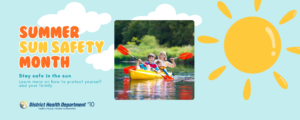
Summer Sun Safety Month: August 2024
Key Facts
According to the U.S. Food and Drug Administration:
- The FDA and the American Academy of Pediatrics (AAP) recommend keeping newborns and babies younger than 6 months out of direct sunlight.
- The best sun protection for these infants is to stay in the shade.
- Spending time in the sun unprotected increases your risk of skin cancer and early skin aging.
- People of all skin colors are at risk for this damage.
- The FDA recommends using broad-spectrum sunscreen with an SPF of 15 or higher, even on cloudy days.
Stay Safe in the Sun
Spending time outside is a great way to be physically active, reduce stress, and get vitamin D. You can work and play outside without raising your skin cancer risk by protecting your skin from the sun.
Most skin cancers are caused by too much exposure to ultraviolet (UV) light. UV rays are an invisible kind of radiation that comes from the sun, tanning beds, and sunlamps. UV rays can damage skin cells.
Protection from UV rays is important all year, not just during the summer. UV rays can reach you on cloudy and cool days, and they reflect off of surfaces like water, cement, sand, and snow. In the continental United States, UV rays tend to be strongest from 10am to 4pm daylight saving time (9am to 3pm standard time).
To help you protect yourself and your family, the skin cancer experts at Moffitt Cancer Center offer the following tips:
- Sunscreen – Before going outside, always apply a waterproof, broad-spectrum sunscreen with a sun protection factor (SPF) of at least 15. Pay particular attention to easily missed areas of your body, such as your ears, the tops of your feet and the part in your hair. Also, remember that sunscreen wears off, so you’ll need to reapply it every two hours, as well as after you swim or sweat.
- Clothing – The best way to protect your skin from sun damage is to cover it with clothing, including a loose-fitting, long-sleeved shirt and long pants made of a tightly woven fabric. Of course, wearing this type of clothing will be impractical if you’re swimming, so be sure to keep a T-shirt or rash guard on hand to cover up with while you’re in the water.
- Hat – Protect your head, ears, face and neck with the shade of a wide-brimmed hat constructed of a tightly woven fabric like canvas (UV rays can penetrate a straw hat). If you wear a baseball cap, be doubly sure to protect your ears and neck with sunscreen.
- Sunglasses – Protect your eyes by wearing wraparound sunglasses that block both UVA and UVB rays (most sunglasses sold in the U.S. meet this requirement, regardless of their cost). Well-designed sunglasses can help shield your eyes from damaging UV rays, prevent cataracts and also protect the delicate skin around your eyes from the harmful effects of sun exposure.
- Shade – Seek shade underneath a shelter, umbrella or tree, especially during the mid-day hours. Even if you are in a shaded area, though, you should still protect yourself with sunscreen, clothing, a hat and sunglasses.
- Water – Be sure to stay well-hydrated by drinking plenty of water throughout the day. While this is always important, it is critical when you are spending time in the sun.
Sunburn
Sunburn is not immediately apparent. Symptoms usually start about 4 hours after sun exposure, worsen in 24–36 hours, and resolve in 3–5 days. They include red, tender and swollen skin, blistering, headache, fever, nausea, and fatigue. In addition to the skin, eyes can become sunburned. Sunburned eyes become red, dry, painful, and feel gritty. Chronic eye exposure can cause permanent damage, including blindness.
First Aid
- Take aspirin, acetaminophen, or ibuprofen to relieve pain, headache, and fever.
- Drink plenty of water to help replace fluid losses.
- Comfort burns with cool baths or the gentle application of cool wet cloths.
- Avoid further exposure until the burn has resolved.
- Use of a topical moisturizing cream, aloe, or 1% hydrocortisone cream may provide additional relief.
If blistering occurs:
- Lightly bandage or cover the area with gauze to prevent infection.
- Do not break blisters. (This slows healing and increases risk of infection.)
- When the blisters break and the skin peels, dried skin fragments may be removed and an antiseptic ointment or hydrocortisone cream may be applied.
Seek medical attention if any of the following occur:
- Severe sunburns covering more than 15% of the body
- Dehydration
- High fever (>101 °F)
- Extreme pain that persists for longer than 48 hours
Quick Links

